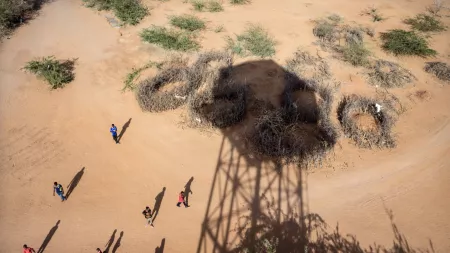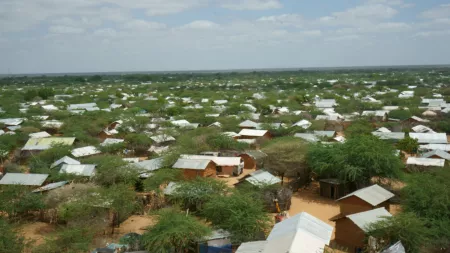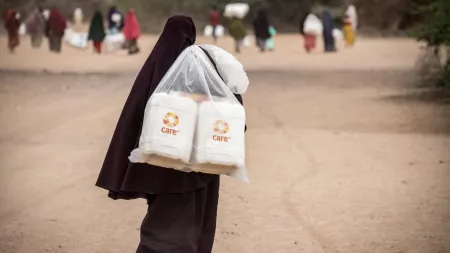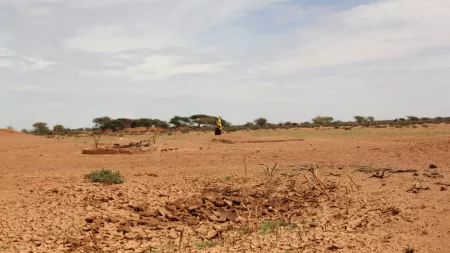At the edge of Dagahaley Refugee Camp located in Northeastern Kenya, 24-year-old Zainab Isak is busy building her temporary shack by tying together twigs with pieces of cloth and poles stuck to the ground. Dagahaley is already at full capacity, so all those arriving have to set up their structures outside the camp.
Since she arrived from her home in Saakow, Somalia, Zainab has been living in other people's structures. Her husband died in June 2022 due to sickness in Baidoa, leaving Zainab to become the breadwinner of her family comprised of her three children, her mother, and her father. As the conditions worsened, Zainab had no option but to leave her home.
As she continues to build, Zainab does not know where her next meal will come from, because she still depends on the goodwill of others in the camp, who also have little food rations. Since she is new to the camp, Zainab is yet to be registered. Only then can she be issued a token that will enable her to access food rations.
“As a farmer, the lack of rain and drought made life unbearable. There was nothing to eat and all we had was finished. That is why we came here,”Zainab said.
On the other side of Dadaab, Halimo Omar is settling into her makeshift kitchen to prepare the day's first meal for her six children and uncle. Halimo, a widow, arrived in Hagadera camp from her home in September 2022 from Dhobley, Somalia after a 15-day walk. “I faced many challenges back home, so I decided to leave with my children. One of the nights while on the way here, one of my daughters was killed by fighters right in front of my eyes,” Halimo narrated.
Leah Kaguara, CARE International in Kenya Country Director said, “We are extremely concerned at the state of women, girls, and children who are arriving at the camp. At present, there are over 99,000 unregistered new arrivals, 51% of who are female. Many of them arrive when they are quite weak and malnourished. Some bear emotional wounds due to the situation they have fled from. The hopelessness in the stories we hear from the new arrivals is heartbreaking.”
Halimo and Zainab are part of the 200 refugees arriving daily at one of the three, already resource-stretched camps, in Dadaab Kenya. From shelter to sanitation facilities, healthcare to water, education to food rations, no sector in Dadaab has been left unaffected even as the worst drought to hit the region in 40 years continues to worsen. The challenge of stretched resources is not unique to new arrivals only but also has affected the more than 333,000 refugees who call Dadaab home.

62-year-old Adel Ali makes her way to the Hagadera Food Distribution Point with the help of her daughter 32-Year-old daughter Rukia Ali. Aden has been living as a refugee in Dadaab for over 20 years. She had fled her war-torn home country in search of safety and a better life. Though she found a moment of respite in the camp, the last couple of years has been quite hard as the drought that has hit the Horn of Africa has made life more difficult.
Today is not her designated day to collect her monthly food rations but due to pre-existing health conditions, she was unable to come for the food earlier. “I was in the hospital for several days and could not come to get my rations. The reason for this is there is a stretch in the available resources so even in the hospital, they were unable to diagnose me properly and give me the right treatment,” Adel says.
On top of her health situation, Adel currently hosts three of her relatives in her home. “Due to the drought, my relatives lost all the camels and goats that they used to herd. As a result, they came to join me in Dadaab. The children were quite hungry. So, with the rations that I get here, I share with them as they are not registered.”

CARE's response
CARE International in Kenya is currently supporting refugees and new arrivals in Dadaab. John Mwangi, CARE Kenya Humanitarian and Refugee Program Manager based in Dadaab said, “We are working across all three camps to provide clean drinking water, food rations, and sanitation facilities to those who are within the camp as well as on the fringes of the camp.”
Between January 2022 and January 2023, CARE International working in partnership with World Food Program has distributed 10,455 Metric Tons of assorted food commodities and 1,080,000 liters of water to the displaced who have found refuge in Dadaab’s camps. As the crisis continues, CARE plans to continue working in Dadaab supporting not only the new arrivals but also the host community.
For media inquiries, please contact David Mutua, Regional Communications Advisor- East Central and Southern Africa via: [email protected].

